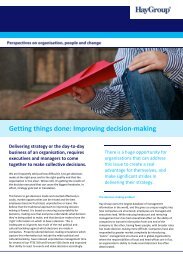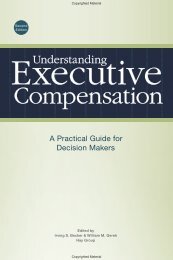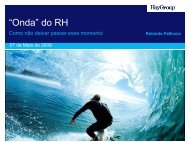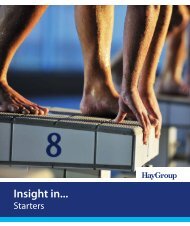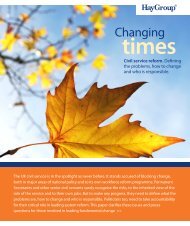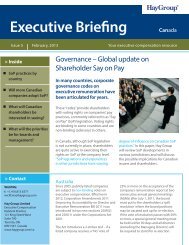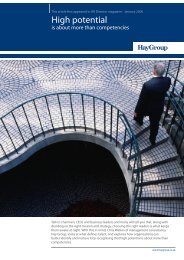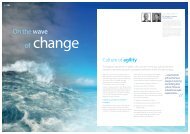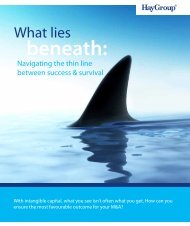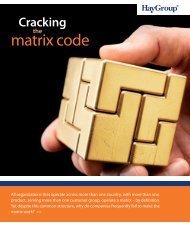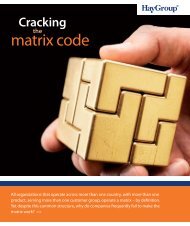Lighting the path to success - Hay Group
Lighting the path to success - Hay Group
Lighting the path to success - Hay Group
You also want an ePaper? Increase the reach of your titles
YUMPU automatically turns print PDFs into web optimized ePapers that Google loves.
<strong>Lighting</strong><br />
<strong>the</strong> <strong>path</strong> <strong>to</strong><br />
<strong>success</strong><br />
Find out what separates <strong>the</strong> FORTUNE<br />
World’s Most Admired Companies from <strong>the</strong> rest.<br />
Click here <strong>to</strong> join our webinar, 18 April 2012 >>
It’s 15 years now since <strong>Hay</strong> <strong>Group</strong> started work<br />
with FORTUNE magazine on <strong>the</strong> annual World’s<br />
Most Admired Companies survey.<br />
Even though <strong>the</strong>re has been phenomenal<br />
change in this period – from boom <strong>to</strong> recession<br />
and back <strong>to</strong> recovery, many of <strong>the</strong> World’s<br />
Most Admired Companies – like GE and Procter<br />
& Gamble – are constants while o<strong>the</strong>rs have<br />
ascended and staked <strong>the</strong>ir own claim <strong>to</strong><br />
Most Admired status. Regardless of business<br />
conditions <strong>the</strong>y continue <strong>to</strong> shine.
Contents<br />
Fifteen years of excellence 2<br />
The study 3<br />
1 Strong, positive cultures that support strategy 4<br />
2 Structures and processes that sustain performance over time 8<br />
3 Achieving <strong>success</strong> through <strong>the</strong>ir people 12<br />
4 Placing a high value on leadership and talent 17<br />
1
2<br />
15 years of FORTUNE<br />
©2012 <strong>Hay</strong> <strong>Group</strong>. All rights reserved<br />
Fifteen years of excellence<br />
Being one of <strong>the</strong> World’s Most Admired Companies (WMACs)<br />
means much more than just peer recognition. The best practices<br />
that help organizations become and remain Most Admired have<br />
direct financial consequences. And as <strong>the</strong> table shows, <strong>the</strong>se<br />
benefits endure over time. Over <strong>the</strong> last 10 years, shareholders<br />
of <strong>to</strong>p <strong>the</strong> 50 World’s Most Admired Companies have enjoyed<br />
returns that outperformed <strong>the</strong> S&P 500 by over five times.<br />
World’s Most Admired Companies outperform industry peers and <strong>the</strong> market as a whole<br />
Total shareholder returns<br />
WMAC S&P 500<br />
One year 22.6% 15.1%<br />
Three years 4.3% (2.8)%<br />
Five years 8.3% 2.3%<br />
Ten years 7.8% 1.4%<br />
And while some companies have made just<br />
a brief appearance at <strong>the</strong> <strong>to</strong>p of <strong>the</strong> rankings,<br />
o<strong>the</strong>rs have been consistent leaders.<br />
These ‘all stars’ include Toyota, Johnson and<br />
Johnson, Berkshire Hathaway, Procter &<br />
Gamble and GE (although in 2011 GE dipped<br />
out of <strong>the</strong> <strong>to</strong>p 10). Technology companies have<br />
become more prominent in recent years, with<br />
Apple <strong>to</strong>pping <strong>the</strong> list each year since 2008.<br />
The 2011 <strong>to</strong>p ten also includes Google, IBM<br />
and Microsoft. BMW and Singapore Airlines<br />
have also joined <strong>the</strong> <strong>to</strong>p 20 in 2011, joining<br />
Toyota in a growing list of non-US companies<br />
ranking as Most Admired.<br />
Regulars at <strong>the</strong> <strong>to</strong>p of <strong>the</strong> WMAC rankings<br />
maintain <strong>the</strong>ir place by scoring consistently<br />
well in all of <strong>the</strong> attributes that <strong>the</strong> World’s<br />
Most Admired Companies survey covers.<br />
See panel ‘The study.’<br />
Even when conditions are <strong>to</strong>ugh,<br />
WMACs prioritize growth
World’s Most Admired Companies industry stars<br />
1997 1998 1999 2000 2001 2002 2003 2004 2005 2006 2007 2008 2009 2010<br />
General Electric<br />
Pro cter & Gamble<br />
Berkshire Hathaway<br />
IBM<br />
Walt Disney<br />
Nestlé<br />
BMW<br />
Occidental Petroleum<br />
Aramark<br />
Costco Wholesale<br />
Goldman Sachs<br />
McDonald’s<br />
Marriott International<br />
Medco Health Solutions<br />
Nextera Energy (FPL)<br />
n Precision<br />
n Consumer products<br />
n Computers and communication<br />
n Financials<br />
n Natural resources<br />
n Media and entertainment<br />
n Transport<br />
n Contracted services<br />
n S<strong>to</strong>res and distributers<br />
n Power<br />
Contents of this report<br />
When all is said and done what is <strong>the</strong><br />
secret of <strong>the</strong>ir <strong>success</strong>? What is it that World’s<br />
Most Admired Companies do differently? Our<br />
report is structured around four essential<br />
ingredients <strong>to</strong> <strong>the</strong> Most Admired Companies’<br />
recipe for <strong>success</strong>:<br />
The study<br />
The Fortune/ <strong>Hay</strong> <strong>Group</strong> global survey of corporate reputations focuses on Fortune 1000<br />
companies, along with <strong>the</strong> largest Global 500 companies and <strong>to</strong>p foreign companies<br />
operating in <strong>the</strong> U.S. These companies are divided in<strong>to</strong> global industry groupings and<br />
questionnaires are <strong>the</strong>n sent <strong>to</strong> industry-specific lists of more than 10,000 senior executives,<br />
board direc<strong>to</strong>rs, and expert analysts. The questionnaire asks respondents <strong>to</strong> rate companies<br />
against nine performance dimensions:<br />
n innovation<br />
1. Strategic excellence<br />
n quality of management<br />
n long-term investment value<br />
n social responsibility <strong>to</strong> <strong>the</strong> community and <strong>the</strong> environment<br />
n ability <strong>to</strong> attract, develop and retain talented people<br />
n quality of products and services<br />
n financial soundness<br />
n wise use of corporate assets<br />
n effectiveness in doing business globally.<br />
2. Structures and processes that sustain<br />
performance over time<br />
3. Achieving <strong>success</strong> through people<br />
4. Placing a high value on leadership and talent<br />
Read on <strong>to</strong> learn what it takes <strong>to</strong> become –<br />
and stay – Most Admired.<br />
The returns are <strong>the</strong>n used <strong>to</strong> calculate an overall reputation score for each company.<br />
3
4<br />
15 years of FORTUNE<br />
Business strategy is<br />
well communicated <strong>to</strong><br />
management<br />
Business strategy is<br />
well communicated <strong>to</strong><br />
employees<br />
©2012 <strong>Hay</strong> <strong>Group</strong>. All rights reserved<br />
1 Strong, positive cultures<br />
that support strategy<br />
This doesn’t just mean World’s Most Admired Companies<br />
are good at making plans (though <strong>the</strong>y are). Where <strong>the</strong>y<br />
shine is in <strong>the</strong>ir ability <strong>to</strong> make strategy happen, by aligning<br />
both <strong>the</strong>ir organizations and <strong>the</strong>ir people with key goals<br />
and objectives, seeing things through.<br />
Strategy that gets executed<br />
Most companies devote a lot of attention<br />
<strong>to</strong> strategic planning. But Most Admired<br />
Companies put those strategies in<strong>to</strong> practice.<br />
Our research suggests that clarity is key.<br />
Within <strong>the</strong> World’s Most Admired Companies,<br />
strategic objectives are clearer at all levels<br />
and performance measures are more closely<br />
aligned with <strong>the</strong>m. And, this effective line<br />
of sight is what contributes <strong>to</strong> <strong>success</strong>.<br />
WMACs hold <strong>the</strong>ir executives more accountable<br />
for communicating and executing business<br />
strategy. Nearly 80 percent of WMACs<br />
Getting <strong>the</strong> strategy message<br />
say managers understand <strong>the</strong>ir roles<br />
in implementing strategy compared <strong>to</strong><br />
58 percent in <strong>the</strong> peer group. And <strong>the</strong>y<br />
are much less <strong>to</strong>lerant of ‘off strategy’<br />
behaviour, with only 22 percent reporting<br />
any degree of <strong>to</strong>lerance in <strong>the</strong>ir organizations<br />
for such behavior seeing it as an acceptable<br />
way <strong>to</strong> meet <strong>the</strong>ir numbers compared <strong>to</strong><br />
52 percent of <strong>the</strong>ir peers.<br />
A strong, stable strategy, clearly<br />
communicated and unders<strong>to</strong>od throughout<br />
<strong>the</strong> organization, serves <strong>the</strong>se exceptional<br />
companies in fair winds and foul.<br />
Most admired<br />
Peer group<br />
0 10 20 30 40 50 60 70 80 100<br />
Source: World’s Most Admired Companies research, 2010
We have succeeded in aligning<br />
our various business units /<br />
subsidiaries around a common<br />
strategic vision<br />
We have effective in<br />
communicating changes in<br />
strategic direction and corporate<br />
policies procedures <strong>to</strong> business<br />
unit / subsidiary managers<br />
In step with strategy<br />
Most admired<br />
Peer group<br />
0 20 40 60 80 100<br />
Source: World’s Most Admired Companies survey, 2010<br />
Fit for purpose structures that<br />
align with strategy<br />
Even though every World’s Most Admired<br />
Company is structurally different, <strong>the</strong>y<br />
share some fundamental elements that<br />
make sure <strong>the</strong>ir strategies work.<br />
In WMACs, structure and strategy are<br />
consistently aligned. So when <strong>to</strong>p companies<br />
take a different strategic route in<strong>to</strong> <strong>the</strong> same<br />
market, <strong>the</strong>y will end up with markedly<br />
Different roles for <strong>the</strong> corporate center<br />
Illinois Tool Works is highly decentralized<br />
and operates in 52 countries, functioning as<br />
850 separate businesses across seven largely<br />
unrelated sec<strong>to</strong>rs. It achieves great results<br />
because of <strong>the</strong> au<strong>to</strong>nomy it gives its business<br />
units and <strong>the</strong> role of <strong>the</strong> corporate center is<br />
kept deliberately small.<br />
Source: World’s Most Admired Companies survey, 2009<br />
different structures. Nestlé, PepsiCo and<br />
General Mills are very different organizations,<br />
for example, even though <strong>the</strong>y compete in<br />
many segments.<br />
Critically, structure is always aligned with <strong>the</strong><br />
business models of <strong>the</strong> WMACs. When looking<br />
at how <strong>the</strong>y should be organized, WMACs<br />
examine <strong>the</strong>ir product portfolios, cus<strong>to</strong>mers,<br />
suppliers, competi<strong>to</strong>rs, geographies and<br />
go-<strong>to</strong>-market models. It’s no surprise that<br />
WMACs are all structurally unique.<br />
3M operates a highly centralized R&D facility<br />
<strong>the</strong>n pushes its research results out <strong>to</strong><br />
au<strong>to</strong>nomous business units. These units <strong>the</strong>n<br />
decide how <strong>to</strong> implement each generation<br />
of new product. Because developments are<br />
based on open source technologies, anyone<br />
can contribute. It’s a virtuous loop.<br />
5
6<br />
15 years of FORTUNE<br />
We have succeeded in aligning<br />
our various business units /<br />
subsidiaries around a common<br />
corporate culture<br />
©2012 <strong>Hay</strong> <strong>Group</strong>. All rights reserved<br />
Strong cultures that are<br />
aligned with strategy<br />
Culture has a major effect on <strong>the</strong> way<br />
employees behave and its impact can be<br />
tracked right through <strong>to</strong> <strong>the</strong> bot<strong>to</strong>m line.<br />
World’s Most Admired Companies understand<br />
<strong>the</strong> importance of culture and go <strong>to</strong> great<br />
lengths <strong>to</strong> create and nurture strong cultures<br />
that are aligned with <strong>the</strong> business strategy.<br />
WMACs recognize that culture is critical <strong>to</strong><br />
making strategy happen. Culture must be<br />
aligned with strategy <strong>to</strong> ensure effective<br />
strategy execution.<br />
Accordingly WMACs place a high priority<br />
on culture. We have found that <strong>the</strong>ir<br />
leaders are clear about <strong>the</strong> attributes<br />
which <strong>the</strong> organization wishes <strong>to</strong> encourage,<br />
support and reward. They also tend <strong>to</strong><br />
have a consistent, shared understanding<br />
Cultural alignment<br />
Source: World’s Most Admired Companies survey, 2010<br />
Most admired<br />
Peer group<br />
0 20 40 60 80 100<br />
Keeping culture on course<br />
of <strong>the</strong>ir company’s present culture and <strong>the</strong><br />
direction it should take in <strong>the</strong> future. WMACs<br />
go <strong>to</strong> great lengths <strong>to</strong> make sure employees<br />
mesh with <strong>the</strong>ir culture, presenting <strong>the</strong>ir<br />
values and <strong>the</strong>ir way of working <strong>to</strong> new<br />
hires <strong>to</strong> evaluate <strong>the</strong> potential fit.<br />
Their cultures promote both teamwork and<br />
individual initiative and WMACs tap in<strong>to</strong> this<br />
combination <strong>to</strong> drive innovation and loyalty.<br />
Culture means business<br />
Representing broadly ‘how things are<br />
done’, organizational cultures are important<br />
drivers of employee behaviour, particularly<br />
when employees must often be relied upon<br />
<strong>to</strong> act on <strong>the</strong>ir own initiative in a way that<br />
is consistent with <strong>the</strong> company’s objectives,<br />
culture and values.<br />
US carrier and WMAC Southwest Airlines has not changed its mission statement in 22 years<br />
and even has a committee tasked with keeping <strong>the</strong> company’s distinctive culture on track.<br />
It’s a powerful force for inspiring loyalty and attracting high performers.<br />
Source: World’s Most Admired Companies survey, 2011
A culture of new ideas<br />
“ Internally, we encourage all our people <strong>to</strong> have an innovative<br />
spirit. Our ‘staff ideas in action’ program, which has run<br />
<strong>success</strong>fully since <strong>the</strong> 1960s, encourages staff <strong>to</strong> contribute ideas<br />
in areas like service innovation, process improvement, cutting<br />
waste or improving our products. To sustain this culture of new<br />
ideas, we also build innovation in<strong>to</strong> our training programs.”<br />
Chris<strong>to</strong>pher Cheng, Senior Vice President Human Resources, Singapore Airlines, quoted in 2011<br />
Even when conditions are <strong>to</strong>ugh,<br />
WMACs prioritize growth<br />
7
8<br />
15 years of FORTUNE<br />
Capture and disseminateideas<br />
and best practices<br />
Innovate in areas<br />
of current strength<br />
Proactively address potential<br />
problems before <strong>the</strong>y occur<br />
Leverage new technologiesand<br />
creative approaches<strong>to</strong> improve<br />
effectiveness<br />
©2012 <strong>Hay</strong> <strong>Group</strong>. All rights reserved<br />
2 Structures and processes that<br />
sustain performance over time<br />
For World’s Most Admired Companies, dealing with<br />
challenges that can trip up lesser organizations –<br />
innovation, going global, reacting fast – is just part<br />
of ‘business as usual’. As a result, <strong>the</strong>y build structures<br />
and ways of working that endure.<br />
Innovation every day<br />
For World’s Most Admired Companies,<br />
innovation is not a separate function –<br />
it’s ‘baked in’ <strong>to</strong> <strong>the</strong> way <strong>the</strong>y work.<br />
Recognizing <strong>the</strong> importance of innovation,<br />
Most Admired Companies have embedded<br />
it in<strong>to</strong> <strong>the</strong>ir cultures. While <strong>the</strong>re is no<br />
‘cookie cutter’ approach for creating an<br />
innovative organization, our results indicate<br />
that WMACs succeed in this. They promote<br />
alignment around a clear leadership vision.<br />
They recognize that having <strong>the</strong> right people<br />
working with <strong>the</strong> right management in<br />
How Most Admired Companies innovate<br />
<strong>the</strong> right environment is essential <strong>to</strong> <strong>the</strong><br />
development of new ideas. And <strong>the</strong>y<br />
ensure that processes and practices are<br />
in place <strong>to</strong> translate innovative activity<br />
in<strong>to</strong> implementation and end results.<br />
0 20 40 60 80 100<br />
Percentage strongly agree/agree<br />
Source: World’s Most Admired Companies survey, 2011<br />
WMACs put employees at <strong>the</strong> heart of <strong>the</strong><br />
innovation process, <strong>the</strong>y are ten percent more<br />
likely than peers <strong>to</strong> see it as ‘very important’.<br />
And if everyone is encouraged <strong>to</strong> proactively<br />
spot problems, fire off ideas and strive <strong>to</strong><br />
improve things that already work just fine, <strong>the</strong><br />
company is in a state of constant innovation.<br />
This readiness <strong>to</strong> improve and change makes<br />
WMACs adaptable <strong>to</strong> fluctuating conditions.<br />
Most admired<br />
Peer group
“ When you’re a company that’s led by innovation, how do you<br />
get everyone <strong>to</strong> understand that it’s not just ‘something for<br />
<strong>the</strong> R&D guys’? BASF addresses this for example by a ‘Simply<br />
Dare’ initiative where employees are asked <strong>to</strong> identify areas for<br />
improvement and are encouraged <strong>to</strong> be a part of <strong>the</strong> solution.<br />
By using a broad network of champions and ‘daredevils’ <strong>to</strong><br />
collect ideas and push <strong>the</strong>m through <strong>to</strong> execution, this has<br />
so far been a hugely <strong>success</strong>ful and engaging activity”<br />
Dr Andre Becker, Senior Vice President, Global Executive Human Resources, BASF, quoted in 2011<br />
Balancing global scale and local<br />
presence<br />
Skill in leveraging <strong>the</strong>ir global reach and<br />
local operations sets World’s Most Admired<br />
Companies apart from <strong>the</strong>ir peers.<br />
In particular, WMACs are able <strong>to</strong> gain<br />
economies of scale from <strong>the</strong>ir global<br />
operations while simultaneously giving<br />
local business units <strong>the</strong> flexibility <strong>to</strong> respond<br />
<strong>to</strong> local market needs.<br />
Structures and processes that sustain<br />
performance over time<br />
WMACs are more <strong>success</strong>ful in developing new<br />
ideas centrally and spreading <strong>the</strong>m worldwide.<br />
On <strong>the</strong> flipside, <strong>the</strong>y are also set up <strong>to</strong> capture<br />
local initiatives and feed <strong>the</strong>se back <strong>to</strong> <strong>the</strong><br />
global organization.<br />
WMACs are well coordinated internationally<br />
<strong>to</strong>o. They unite far-flung and disparate<br />
businesses around strong, consistent<br />
strategies and cultures. And <strong>the</strong>ir performance<br />
management systems are designed <strong>to</strong> reward<br />
behaviors that benefit <strong>the</strong> whole enterprise,<br />
not just <strong>the</strong> local operation.<br />
Local flexibility. 84 percent of WMACs can<br />
respond flexibly <strong>to</strong> local market needs,<br />
compared with 73 percent of peers<br />
Spreading ideas. 78 percent of WMACs are<br />
good at spotting new ideas and leveraging<br />
<strong>the</strong>m throughout <strong>the</strong> organization. Only slightly<br />
more than half of peers can say <strong>the</strong> same.<br />
Procter & Gamble: simultaneously global and local<br />
For P&G’s large, global brands, a centralized brand manager makes major brand decisions<br />
and sets parameters for local market au<strong>to</strong>nomy. But for P&G’s local brands, <strong>the</strong> situation is<br />
completely reversed. Local managers make local decisions, using local resources.<br />
They still adhere <strong>to</strong> P&G’s global brand frameworks, but <strong>the</strong>y are empowered <strong>to</strong> act <strong>to</strong> serve<br />
local best interests.<br />
Source: World’s Most Admired Companies research, 2009<br />
“ The secret of our <strong>success</strong> is collaboration between our verticals<br />
and local managers in <strong>the</strong>ir respective countries”<br />
Dr. Nicolas von Rosty, Corporate Vice President Executive Development, Siemens<br />
9
10 15 years of FORTUNE<br />
©2012 <strong>Hay</strong> <strong>Group</strong>. All rights reserved<br />
Focused on <strong>the</strong> long term<br />
World’s Most Admired Companies look<br />
way beyond <strong>the</strong> next quarter.<br />
Our work with FORTUNE reinforces o<strong>the</strong>r studies<br />
that show how <strong>success</strong>ful companies share<br />
a greater emphasis on <strong>the</strong> future than peers.<br />
They deliberately build strategies that work at<br />
all points of <strong>the</strong> business cycle, so <strong>the</strong>re isn’t<br />
a need for radical change when a downturn<br />
strikes or <strong>the</strong> recovery starts. In this way,<br />
Staying admired<br />
WMACs avoid <strong>the</strong> distraction of frequent<br />
strategic change that is a common problem<br />
for less focused organizations.<br />
WMACs manage people for <strong>the</strong> long term<br />
<strong>to</strong>o. They pick out high-potential employees<br />
and develop <strong>the</strong>m over time with a series<br />
of planned assignments. And <strong>the</strong>y reward<br />
for <strong>the</strong> long term. WMACs are 56 percent<br />
more likely than peers <strong>to</strong> have performance<br />
measures based on building cus<strong>to</strong>mer loyalty.<br />
WMACs long-term focus means many names consistently score high in <strong>the</strong> list:<br />
BERKSHIRE HATHAWAY INC.
Agility that protects against<br />
change and exploits opportunity<br />
Like <strong>success</strong>ful creatures in nature,<br />
WMACs are quicker than o<strong>the</strong>rs <strong>to</strong> find<br />
and exploit new opportunities. They<br />
are naturally agile, making <strong>the</strong>m highly<br />
adaptable so <strong>the</strong>y can sustain performance<br />
in good times and bad.<br />
It’s <strong>the</strong> combination of several key WMAC<br />
attributes that creates this adaptability.<br />
Their active focus on growth means, among<br />
o<strong>the</strong>r things, that <strong>the</strong>y are better positioned <strong>to</strong><br />
benefit after a downturn. And with innovation<br />
‘baked in’ <strong>to</strong> WMACs, improvements and new<br />
initiatives are a constant feature ra<strong>the</strong>r than<br />
an occasional project. Much more than peers,<br />
WMACs reach out <strong>to</strong> employees for ideas,<br />
meaning that everyone is part of <strong>the</strong> solution.<br />
And by enabling employees, <strong>the</strong>y ensure<br />
that motivation is translated in<strong>to</strong> productivity,<br />
even in difficult times.<br />
n 83 percent of WMACs innovate in areas<br />
of current strength<br />
n 83 percent of WMACs proactively address<br />
potential problems before<br />
<strong>the</strong>y occur<br />
n 91 percent of WMACs regularly reach<br />
out <strong>to</strong> employees for ideas on how <strong>to</strong><br />
improve efficiency<br />
n 89 percent of WMACs ensure employee<br />
skills keep pace with job demands<br />
11
12 15 years of FORTUNE<br />
©2012 <strong>Hay</strong> <strong>Group</strong>. All rights reserved<br />
3 Achieving <strong>success</strong> through<br />
<strong>the</strong>ir people<br />
It’s perhaps <strong>the</strong> most consistent <strong>the</strong>me in our<br />
15 years of work with World’s Most Admired<br />
Companies. Recognizing that <strong>the</strong>ir employees<br />
are <strong>the</strong> key driver of <strong>the</strong>ir <strong>success</strong>, <strong>the</strong>se<br />
<strong>to</strong>p-performing organizations go <strong>to</strong> great lengths<br />
<strong>to</strong> create <strong>the</strong> right conditions for people <strong>to</strong> thrive.<br />
Looking after human capital<br />
“Our people are our greatest asset”<br />
may sound like a platitude. But our<br />
research shows that for WMACs, it’s<br />
core <strong>to</strong> <strong>the</strong>ir <strong>success</strong>.<br />
Most Admired Companies recognize <strong>the</strong><br />
value of <strong>the</strong> ‘intangible asset’ <strong>the</strong>ir workforce<br />
presents. Indeed <strong>the</strong>y understand that<br />
not only people, but <strong>the</strong>ir motivation,<br />
development, and <strong>the</strong> climates in which<br />
<strong>the</strong>y work are all assets <strong>to</strong>o.<br />
Compared <strong>to</strong> peers, WMACs are 22 percent<br />
more likely <strong>to</strong> have a human capital strategy<br />
in place that has been reviewed and approved<br />
at board level. And 80 percent of WMACs<br />
regularly review human capital metrics such<br />
as employee turnover, employee engagement,<br />
recruitment and job offer acceptance rates.<br />
While WMACs evaluate <strong>the</strong>ir CEOs on financial<br />
and strategic <strong>success</strong> similarly <strong>to</strong> <strong>the</strong>ir peers,<br />
<strong>the</strong>y are 23 percent more likely <strong>to</strong> evaluate<br />
CEOs on <strong>success</strong> in developing human capital.<br />
“ My main job was developing<br />
talent. I was a gardener<br />
providing water and o<strong>the</strong>r<br />
nourishment <strong>to</strong> our <strong>to</strong>p<br />
750 people. Of course, I had<br />
<strong>to</strong> pull out some weeds, <strong>to</strong>o.”<br />
Jack Welch, former CEO of GE, <strong>the</strong> highestscoring<br />
World’s Most Admired Company
Planned career<br />
assignments are<br />
used a great deal<br />
Engagement that inspires<br />
employees <strong>to</strong> ‘go <strong>the</strong> extra mile’<br />
When employees are highly motivated,<br />
<strong>the</strong>y are more likely <strong>to</strong> give <strong>the</strong> extra<br />
‘discretionary’ effort that’s particularly<br />
important in <strong>to</strong>ugh times. World’s Most<br />
Admired Companies make big investments<br />
in engagement.<br />
WMACs continue <strong>to</strong> focus on engagement,<br />
even in <strong>to</strong>ugh times. When we carried out<br />
our 2010 study with FORTUNE, we found<br />
World’s Most Admired Companies were<br />
emerging from recession with better levels<br />
of loyalty than before. Nearly 70 percent<br />
of <strong>the</strong>m reported better engagement levels<br />
post-downturn, linked no doubt <strong>to</strong> <strong>the</strong> fact<br />
that <strong>the</strong>y had <strong>to</strong> implement only half <strong>the</strong>ir<br />
peers’ levels of hiring freezes and layoffs.<br />
Our findings suggest that WMACs are<br />
more likely <strong>to</strong> have developed explicit<br />
employer brands <strong>to</strong> capture distinctive and<br />
differentiating aspects of <strong>the</strong> work experience<br />
in <strong>the</strong>ir organizations <strong>to</strong> attract and retain<br />
key talent. They are also more likely <strong>to</strong><br />
have developed a specific definition of<br />
employee engagement – and <strong>to</strong> report that<br />
HR staff members across <strong>the</strong> company have<br />
a good understanding of it. But employee<br />
engagement is not viewed as exclusively<br />
an HR responsibility in WMACs. In terms<br />
of ownership of engagement initiatives,<br />
Investment in personal growth<br />
One-<strong>to</strong>-one coaching<br />
is used a great deal Most admired<br />
Peer group<br />
line manager responsibility is markedly<br />
higher in <strong>the</strong>se organizations.<br />
The greater clarity and accountability<br />
surrounding employee engagement issues<br />
in WMACs leads <strong>to</strong> greater effectiveness<br />
and impact. WMACs have a more positive<br />
view of <strong>the</strong> <strong>success</strong> of <strong>the</strong>ir engagement<br />
efforts in creating a competitive advantage,<br />
reducing complaints about pay fairness<br />
and equity, reducing turnover, reducing<br />
employee performance problems and<br />
streng<strong>the</strong>ning relationships with cus<strong>to</strong>mers.<br />
But <strong>the</strong> benefits of <strong>the</strong> enhanced engagement<br />
levels in WMACs extend beyond <strong>the</strong> boundaries<br />
of <strong>the</strong> organization. As employee engagement<br />
has come <strong>to</strong> be recognized as a major driver<br />
of business performance, engagement<br />
metrics have emerged as important markers<br />
of an organization’s current health and future<br />
prospects. Notably, WMACs do more <strong>to</strong><br />
communicate employee engagement levels<br />
externally <strong>to</strong> inves<strong>to</strong>rs, prospective hires,<br />
and current/prospective cus<strong>to</strong>mers.<br />
How do WMACs keep people engaged?<br />
Partly it’s <strong>to</strong> do with empowerment. But it<br />
also has <strong>to</strong> do with personal advancement<br />
and growth. Planned career assignments<br />
and one-<strong>to</strong>-one coaching, for example,<br />
are used much more widely at WMACs<br />
and inspire motivation, especially during<br />
periods of economic uncertainty.<br />
0 10 20 30 40 50 60 70<br />
Source: World’s Most Admired Companies survey, 2010<br />
13
14 15 years of FORTUNE<br />
©2012 <strong>Hay</strong> <strong>Group</strong>. All rights reserved<br />
Engagement cuts costs<br />
Nearly all WMACs report that engagement<br />
cuts staff turnover. Given it costs between<br />
50 and 150 percent of salary <strong>to</strong> replace an<br />
employee, <strong>the</strong> savings are clear.<br />
Engagement drives growth<br />
<strong>Hay</strong> <strong>Group</strong> research suggests that firms<br />
with high levels of engagement see revenue<br />
growth 2.5x that of peers and a 40 percent<br />
reduction in employee turnover.<br />
But engagement is only part<br />
of <strong>the</strong> s<strong>to</strong>ry<br />
Even when employees are highly motivated<br />
<strong>the</strong>y can often struggle <strong>to</strong> be productive.<br />
The missing piece is ‘enablement’ –<br />
removing <strong>the</strong> barriers <strong>to</strong> performance<br />
so engagement translates in<strong>to</strong> results.<br />
As <strong>the</strong> next section shows, <strong>the</strong> business<br />
case for doing this is clear.<br />
“ Our philosophy is that you can’t have business growth without<br />
personal growth. In fact, <strong>the</strong>y’re inseparable. When <strong>the</strong> business<br />
is growing and you’ve got employees that are <strong>the</strong>mselves<br />
growing professionally it’s a very powerful combination and<br />
one can really drive <strong>the</strong> o<strong>the</strong>r”<br />
David Henderson, SVP of Talent Management, PepsiCo, quoted in 2011<br />
“ At <strong>the</strong> end of <strong>the</strong> day, when you’ve got lots of employees feeling<br />
very good about what <strong>the</strong>y get out of a company, you’re going <strong>to</strong><br />
end up with lots of employees expending discretionary effort.”<br />
Richard Floersch, executive vice president and chief human resource officer, McDonald’s<br />
WMACs leverage <strong>the</strong>ir<br />
employees by helping everyone<br />
<strong>to</strong> be part of <strong>the</strong> solution
Address work-life<br />
balance issues<br />
Address frustrations over<br />
work conditions that<br />
inhibit <strong>success</strong><br />
Respond <strong>to</strong> <strong>the</strong> needs of<br />
different generations in<br />
<strong>the</strong> workforce<br />
High<br />
engagement only<br />
High engagement<br />
+ high enablement<br />
Enablement: turning motivation<br />
in<strong>to</strong> results<br />
World’s Most Admired Companies understand<br />
that for employees, motivation alone is not<br />
enough. People must also feel equipped and<br />
empowered <strong>to</strong> ‘get <strong>the</strong> job done’.<br />
<strong>Hay</strong> <strong>Group</strong> research shows that while nine<br />
out of ten employees are committed <strong>to</strong><br />
<strong>success</strong>, less than two-thirds believe <strong>the</strong>y<br />
are as productive as <strong>the</strong>y could be. That’s<br />
a lot of wasted eagerness and it’s something<br />
that WMACs grasp. They channel employees’<br />
motivation in<strong>to</strong> results by:<br />
How WMACs remove <strong>the</strong> barriers <strong>to</strong> productivity<br />
As <strong>Hay</strong> <strong>Group</strong> studies have shown, <strong>the</strong>re is a significant<br />
financial benefit from ensuring employees are enabled<br />
Employee<br />
performance<br />
Increase in<br />
employees above<br />
peformance<br />
expectations<br />
10%<br />
50%<br />
Employee<br />
retention<br />
Reduction in<br />
turnover rates<br />
-40%<br />
-54%<br />
n Working ‘smarter’ – simplifying work<br />
processes<br />
n Creating systems and processes – such<br />
as effective reward – that encourage<br />
employees <strong>to</strong> become part of <strong>the</strong> solution<br />
n Prioritizing work/life balance issues <strong>to</strong><br />
sustain performance and avoid burnout<br />
n Ensuring that employees’ skills remain<br />
aligned with changing work demands<br />
Leaders at WMACs are 30 percent more<br />
likely <strong>to</strong> expect employees <strong>to</strong> lead.<br />
Cus<strong>to</strong>mer<br />
satisfaction<br />
Cus<strong>to</strong>mer<br />
satisfaction<br />
rates<br />
71%<br />
89%<br />
Most admired<br />
Peer group<br />
0 20 40 60 80 100<br />
Percentage <strong>to</strong>p prority / very important<br />
Source: World’s Most Admired Companies survey, 2010World’s Most Admired Companies<br />
survey, 2010:<br />
Based on linkage case studies using <strong>Hay</strong> <strong>Group</strong>’s<br />
global normative database<br />
Financial<br />
<strong>success</strong><br />
Revenue growth<br />
x2.5<br />
x4.5<br />
15
16 15 years of FORTUNE<br />
Well defined for<br />
CEO and executive<br />
<strong>success</strong>ion<br />
More likely <strong>to</strong> hire a<br />
new CEO from inside<br />
<strong>the</strong> organization<br />
©2012 <strong>Hay</strong> <strong>Group</strong>. All rights reserved<br />
“ We’re a ‘learning organization’ with a culture of constantly<br />
upgrading ourselves. Our training budget is about 12 percent<br />
of our payroll and we’re constantly adapting our programs <strong>to</strong><br />
make sure employees’ skills are up-<strong>to</strong>-date”<br />
Chris<strong>to</strong>pher Cheng, Senior Vice President Human Resources, Singapore Airlines, quoted in 2011<br />
Succession and onboarding<br />
Just as critical as World’s Most Admired<br />
Companies keeping a close watch on strategy,<br />
<strong>the</strong>y keep a focus on <strong>the</strong>ir leadership pipeline.<br />
Over 90 percent of WMACs have well-defined<br />
<strong>success</strong>ion plans while only 65 percent of <strong>the</strong>ir<br />
peer group are making careful plans <strong>to</strong> ensure<br />
<strong>to</strong>p-team continuity. They are more likely<br />
<strong>to</strong> have emergency <strong>success</strong>ion plans <strong>to</strong>o,<br />
for <strong>to</strong>p officers as well as <strong>the</strong> CEO.<br />
Having greater bench strength internally<br />
maintain continuity and provides WMACs<br />
with greater ability <strong>to</strong> avoid having <strong>to</strong> opt for<br />
costly external hires.<br />
WMACs don’t just take care of <strong>the</strong> <strong>to</strong>p team,<br />
though. They place a great deal of emphasis<br />
on looking after <strong>the</strong>ir workforces, carefully<br />
integrating new hires and <strong>the</strong>n keeping<br />
<strong>the</strong>ir skills sharp once <strong>the</strong>y’re on board.<br />
They have an eye on long-term people trends<br />
<strong>to</strong>o. Our studies show that WMACs tweak <strong>the</strong>ir<br />
employer value propositions <strong>to</strong> reflect <strong>the</strong><br />
different needs of different groups: millennials,<br />
Generation X, baby boomers and veterans,<br />
and people at different life stages.<br />
“ Our onboarding process starts way before someone joins us<br />
for his or her first day. We have a pre-hire experience, <strong>the</strong>n an<br />
‘enculturation’ period, <strong>the</strong>n <strong>the</strong> skills training piece. Overall,<br />
for <strong>the</strong> first 90 days we really try <strong>to</strong> orient people <strong>to</strong> who we<br />
are and what we stand for”<br />
Karin Princivalle, Senior Vice President of Human Resources, Medco, quoted in 2011<br />
Planned <strong>success</strong>ion<br />
Most admired<br />
Peer group<br />
0 20 40 60 80 100<br />
Source: World’s Most Admired Companies survey, 2010
4 Placing a high value on leadership<br />
and talent<br />
For <strong>success</strong> <strong>to</strong> be driven by people, organizations must<br />
also ensure that <strong>the</strong>y have <strong>the</strong> best talent, and <strong>the</strong><br />
best leaders. This strong focus on leadership and talent<br />
has been a standout feature of World’s Most Admired<br />
Companies since our work with FORTUNE began.<br />
Focused on attracting and<br />
developing <strong>the</strong> right talent<br />
Throughout our 15 years of work with<br />
World’s Most Admired Companies, we’ve<br />
found that <strong>the</strong>y consistently work hard<br />
<strong>to</strong> ensure <strong>the</strong> right talent is in place.<br />
WMACs always do three things well:<br />
n rigorous selection procedures for<br />
evaluating new hires<br />
n strong emphasis on growth and<br />
development opportunities<br />
n close linkage of pay and performance.<br />
WMACs also work hard <strong>to</strong>day <strong>to</strong> burnish <strong>the</strong>ir<br />
employer brand, a critical fac<strong>to</strong>r when talent<br />
in many important areas is surprisingly scarce.<br />
They are on <strong>to</strong>p of trends such as <strong>the</strong> need<br />
for more flexible working, <strong>the</strong> differing needs<br />
of different generations and <strong>the</strong> diversity<br />
of cultures in which <strong>the</strong>y operate.<br />
World’s Most Admired Companies’ focus<br />
on attracting and developing people means<br />
<strong>the</strong>y can attract <strong>the</strong> best while avoiding<br />
overpaying for <strong>to</strong>p talent.<br />
“ Companies that have a reputation for growing and developing<br />
people, and deploying <strong>the</strong>m in assignments that stretch <strong>the</strong>ir<br />
capabilities, attract <strong>the</strong> best talent,” he says. “It becomes a<br />
repeatable cycle: attract, develop, deploy, compete. When<br />
companies consistently do this, <strong>the</strong>y achieve a talent advantage<br />
that makes <strong>the</strong>m agile, adaptable and best-in-class.”<br />
Moheet Nagrath, global human resource officer, Procter & Gamble<br />
17
18 15 years of FORTUNE<br />
Increasing presence in<br />
emerging markets<br />
©2012 <strong>Hay</strong> <strong>Group</strong>. All rights reserved<br />
Leadership excellence<br />
Effective leadership sets <strong>the</strong> best apart from<br />
<strong>the</strong> rest. It’s been a consistent <strong>the</strong>me of our<br />
work with WMACs over 15 years.<br />
World’s Most Admired Companies place a<br />
premium on <strong>the</strong> importance of leadership and<br />
do a better job of selecting and developing<br />
leaders. Their leaders take a ‘hands on’<br />
approach <strong>to</strong> developing talent, devoting as<br />
much as 30 percent of <strong>the</strong>ir time <strong>to</strong> <strong>the</strong> task.<br />
Leadership satisfaction<br />
Source: World’s Most Admired Companies survey, 2011<br />
We have found six standout <strong>the</strong>mes in our<br />
studies. WMACs:<br />
1. place more value on leadership<br />
development<br />
2. use competency models and developmental<br />
programs more frequently when choosing<br />
and promoting leaders<br />
3. are less <strong>to</strong>lerant of inappropriate behaviour<br />
<strong>to</strong> ‘meet <strong>the</strong> numbers’<br />
4. have leaders who demonstrate better<br />
emotional intelligence<br />
5. equip <strong>the</strong>ir leaders better<br />
Supporting and managing<br />
fast-growing business<br />
units/subsidiaries Most admired<br />
Peer group<br />
6. are significantly more satisfied with <strong>the</strong><br />
quality and breadth of senior leadership.<br />
0 20 40 60 80 100<br />
Percentage <strong>to</strong>p priority/very important<br />
“ We co-create leadership<br />
programs with our executives,<br />
because <strong>the</strong>y’re experts in<br />
running <strong>the</strong>ir business and<br />
we’re experts in how people<br />
learn, grow and develop”<br />
Annmarie Neil, Psy D, Vice President and<br />
Chief Talent Officer at Cisco
Link reward <strong>to</strong><br />
performance<br />
Unlocking <strong>the</strong> value of reward<br />
programs<br />
Reward is essential <strong>to</strong> attracting and retaining<br />
staff at all levels. It’s also an essential <strong>to</strong>ol for<br />
driving performance, particularly in <strong>to</strong>ugh<br />
economic conditions. World’s Most Admired<br />
Companies realize this – and <strong>the</strong>y make<br />
reward work harder for <strong>the</strong>m <strong>to</strong>o, getting<br />
more ROI from it.<br />
How do WMACs get more for less? There<br />
is no single key <strong>to</strong> <strong>success</strong>. Ra<strong>the</strong>r, several<br />
practices come <strong>to</strong>ge<strong>the</strong>r <strong>to</strong> put <strong>the</strong>m in<br />
this enviable position:<br />
1. Make sure reward is aligned – with your<br />
strategy and culture. WMACs’ reward<br />
programs show a high degree of stability<br />
over time, which helps <strong>the</strong>m stay on course<br />
strategically.<br />
2. Promote a ‘<strong>to</strong>tal reward’ approach that<br />
makes best use of intangible components,<br />
for example flexible working. Companies<br />
get more mileage out of reward when<br />
employees understand and appreciate<br />
that it consists of both monetary as well<br />
as o<strong>the</strong>r components.<br />
3. Engage line managers in <strong>the</strong> rollout of<br />
reward programs. As <strong>the</strong>y take <strong>the</strong> lead<br />
role in planning, coaching and assessing<br />
employee performance, line managers<br />
are well positioned <strong>to</strong> influence employees<br />
about <strong>the</strong> extent and relevance of<br />
reward programs.<br />
4. Communicate reward strategies effectively.<br />
Explaining <strong>the</strong>ir rationale is key. WMACs are<br />
much better than peers at documenting<br />
<strong>the</strong>ir reward philosophy and providing<br />
<strong>to</strong>tal reward statements.<br />
5. Focus on execution, not design. WMACs<br />
are more effective than peers in executing<br />
<strong>the</strong>ir rewards programs on a global basis.<br />
6. Link reward tightly <strong>to</strong> performance.<br />
Aligning performance metrics <strong>to</strong> reward<br />
encourages higher levels of performance.<br />
82 percent of WMACs reinforce <strong>the</strong>ir reward<br />
strategy in communications with employees<br />
At three-quarters of WMACs, employees<br />
understand that reward has both tangible<br />
and intangible components<br />
“ We pay well, we have rich benefits and we do a good job<br />
of articulating those benefits <strong>to</strong> our employees”<br />
James Brickey, head of HR and <strong>to</strong>tal rewards, Anheuser-Busch<br />
At World’s Most Admired Companies, reward is more closely linked <strong>to</strong> performance<br />
Most admired<br />
Peer group<br />
0 20 40 60 80 100<br />
Percentage strongly agree/agree<br />
Source: World’s Most Admired Companies survey, 2010<br />
19
20 15 years of FORTUNE<br />
©2012 <strong>Hay</strong> <strong>Group</strong>. All rights reserved<br />
Paying more for performance<br />
While <strong>the</strong>ir base salaries can be up <strong>to</strong> five percent lower than peers, WMACs pay <strong>the</strong>ir<br />
very <strong>to</strong>p people more than average – up <strong>to</strong> 20 percent more when bonuses are taken<br />
in<strong>to</strong> account. These people are being rewarded for <strong>the</strong>ir ability <strong>to</strong> deliver and ensure<br />
<strong>the</strong>ir companies stay at <strong>the</strong> <strong>to</strong>p of <strong>the</strong>ir sec<strong>to</strong>rs. They are <strong>the</strong> ones who are driving strategy<br />
and motivation <strong>the</strong>ir people.<br />
Summary<br />
While <strong>the</strong>re is no magic formula that<br />
companies follow <strong>to</strong> become Most Admired,<br />
<strong>the</strong> fifteen years of our study with FORTUNE<br />
have shown that consistent performance in<br />
four specific areas is something that all <strong>the</strong><br />
<strong>to</strong>p companies have in common.<br />
They are able not only <strong>to</strong> devise great<br />
strategies, but put <strong>the</strong>m in<strong>to</strong> practice <strong>to</strong>o.<br />
And WMACs structure <strong>the</strong>mselves for <strong>the</strong><br />
long term, by making <strong>the</strong>mselves able <strong>to</strong><br />
deal effectively with short-term opportunities<br />
and threats. They go <strong>to</strong> great lengths <strong>to</strong> create<br />
<strong>the</strong> right conditions for <strong>the</strong>ir people <strong>to</strong> thrive.<br />
Finally, <strong>the</strong>y make sure <strong>the</strong>y have <strong>the</strong> right<br />
leaders and <strong>the</strong> right talent.<br />
Added <strong>to</strong>ge<strong>the</strong>r, <strong>the</strong>se practices create<br />
organizations that outperform <strong>the</strong>ir peers,<br />
year after year.
22 15 years of FORTUNE<br />
Africa<br />
Cape Town<br />
Johannesburg<br />
Pre<strong>to</strong>ria<br />
Asia<br />
Bangkok<br />
Beijing<br />
Ho Chi Minh City<br />
Hong Kong<br />
Jakarta<br />
Kuala Lumpur<br />
Mumbai<br />
New Delhi<br />
Seoul<br />
Shanghai<br />
Shenzhen<br />
Singapore<br />
Tokyo<br />
Europe<br />
Amsterdam<br />
A<strong>the</strong>ns<br />
Barcelona<br />
Berlin<br />
Bilbao<br />
Birmingham<br />
Bratislava<br />
Brussels<br />
Bucharest<br />
Budapest<br />
Dublin<br />
Enschede<br />
<strong>Hay</strong> <strong>Group</strong> is a global management consulting firm that works with<br />
leaders <strong>to</strong> transform strategy in<strong>to</strong> reality. We develop talent, organize<br />
people <strong>to</strong> be more effective and motivate <strong>the</strong>m <strong>to</strong> perform at <strong>the</strong>ir<br />
best. Our focus is on making change happen and helping people and<br />
organizations realize <strong>the</strong>ir potential.<br />
We have over 2,600 employees working in 86 offices in 49 countries.<br />
Our clients are from <strong>the</strong> private, public and not-for-profit sec<strong>to</strong>rs, across<br />
every major industry. For more information please contact your local<br />
office through www.haygroup.com.<br />
©2012 <strong>Hay</strong> <strong>Group</strong>. All rights reserved<br />
Frankfurt<br />
Glasgow<br />
Helsinki<br />
Istanbul<br />
Kiev<br />
Lille<br />
Lisbon<br />
London<br />
Madrid<br />
Manchester<br />
Milan<br />
Moscow<br />
Oslo<br />
Paris<br />
Prague<br />
Rome<br />
S<strong>to</strong>ckholm<br />
Strasbourg<br />
Vienna<br />
Vilnius<br />
Warsaw<br />
Zeist<br />
Zurich<br />
Latin America<br />
Bogotá<br />
Buenos Aires<br />
Caracas<br />
Lima<br />
Mexico City<br />
San José<br />
Santiago<br />
São Paulo<br />
Middle East<br />
Dubai<br />
Riyadh<br />
Tel Aviv<br />
North America<br />
Atlanta<br />
Bos<strong>to</strong>n<br />
Calgary<br />
Chicago<br />
Dallas<br />
Edmon<strong>to</strong>n<br />
Halifax<br />
Kansas City<br />
Los Angeles<br />
Montreal<br />
New York Metro<br />
Ottawa<br />
Philadelphia<br />
Regina<br />
San Francisco<br />
Toron<strong>to</strong><br />
Vancouver<br />
Washing<strong>to</strong>n DC Metro<br />
Pacific<br />
Auckland<br />
Brisbane<br />
Melbourne<br />
Perth<br />
Sydney<br />
Welling<strong>to</strong>n



